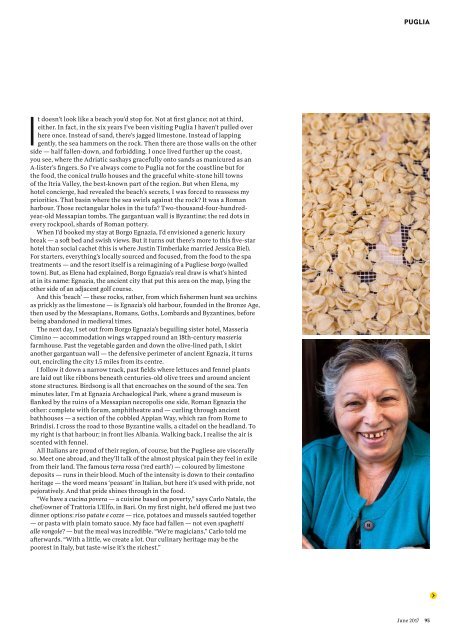National_Geographic_Traveller_UK_June_2017
Create successful ePaper yourself
Turn your PDF publications into a flip-book with our unique Google optimized e-Paper software.
PUGLIA<br />
It doesn’t look like a beach you’d stop for. Not at first glance; not at third,<br />
either. In fact, in the six years I’ve been visiting Puglia I haven’t pulled over<br />
here once. Instead of sand, there’s jagged limestone. Instead of lapping<br />
gently, the sea hammers on the rock. Then there are those walls on the other<br />
side — half fallen-down, and forbidding. I once lived further up the coast,<br />
you see, where the Adriatic sashays gracefully onto sands as manicured as an<br />
A-lister’s fingers. So I’ve always come to Puglia not for the coastline but for<br />
the food, the conical trullo houses and the graceful white-stone hill towns<br />
of the Itria Valley, the best-known part of the region. But when Elena, my<br />
hotel concierge, had revealed the beach’s secrets, I was forced to reassess my<br />
priorities. That basin where the sea swirls against the rock? It was a Roman<br />
harbour. Those rectangular holes in the tufa? Two-thousand-four-hundredyear-old<br />
Messapian tombs. The gargantuan wall is Byzantine; the red dots in<br />
every rockpool, shards of Roman pottery.<br />
When I’d booked my stay at Borgo Egnazia, I’d envisioned a generic luxury<br />
break — a soft bed and swish views. But it turns out there’s more to this five-star<br />
hotel than social cachet (this is where Justin Timberlake married Jessica Biel).<br />
For starters, everything’s locally sourced and focused, from the food to the spa<br />
treatments — and the resort itself is a reimagining of a Pugliese borgo (walled<br />
town). But, as Elena had explained, Borgo Egnazia’s real draw is what’s hinted<br />
at in its name: Egnazia, the ancient city that put this area on the map, lying the<br />
other side of an adjacent golf course.<br />
And this ‘beach’ — these rocks, rather, from which fishermen hunt sea urchins<br />
as prickly as the limestone — is Egnazia’s old harbour, founded in the Bronze Age,<br />
then used by the Messapians, Romans, Goths, Lombards and Byzantines, before<br />
being abandoned in medieval times.<br />
The next day, I set out from Borgo Egnazia’s beguiling sister hotel, Masseria<br />
Cimino — accommodation wings wrapped round an 18th-century masseria<br />
farmhouse. Past the vegetable garden and down the olive-lined path, I skirt<br />
another gargantuan wall — the defensive perimeter of ancient Egnazia, it turns<br />
out, encircling the city 1.5 miles from its centre.<br />
I follow it down a narrow track, past fields where lettuces and fennel plants<br />
are laid out like ribbons beneath centuries-old olive trees and around ancient<br />
stone structures. Birdsong is all that encroaches on the sound of the sea. Ten<br />
minutes later, I’m at Egnazia Archaelogical Park, where a grand museum is<br />
flanked by the ruins of a Messapian necropolis one side, Roman Egnazia the<br />
other: complete with forum, amphitheatre and — curling through ancient<br />
bathhouses — a section of the cobbled Appian Way, which ran from Rome to<br />
Brindisi. I cross the road to those Byzantine walls, a citadel on the headland. To<br />
my right is that harbour; in front lies Albania. Walking back, I realise the air is<br />
scented with fennel.<br />
All Italians are proud of their region, of course, but the Pugliese are viscerally<br />
so. Meet one abroad, and they’ll talk of the almost physical pain they feel in exile<br />
from their land. The famous terra rossa (‘red earth’) — coloured by limestone<br />
deposits — runs in their blood. Much of the intensity is down to their contadino<br />
heritage — the word means ‘peasant’ in Italian, but here it’s used with pride, not<br />
pejoratively. And that pride shines through in the food.<br />
“We have a cucina povera — a cuisine based on poverty,” says Carlo Natale, the<br />
chef/owner of Trattoria L’Elfo, in Bari. On my first night, he’d offered me just two<br />
dinner options: riso patate e cozze — rice, potatoes and mussels sautéed together<br />
— or pasta with plain tomato sauce. My face had fallen — not even spaghetti<br />
alle vongole? — but the meal was incredible. “We’re magicians,” Carlo told me<br />
afterwards. “With a little, we create a lot. Our culinary heritage may be the<br />
poorest in Italy, but taste-wise it’s the richest.”<br />
<strong>June</strong> <strong>2017</strong> 95


















